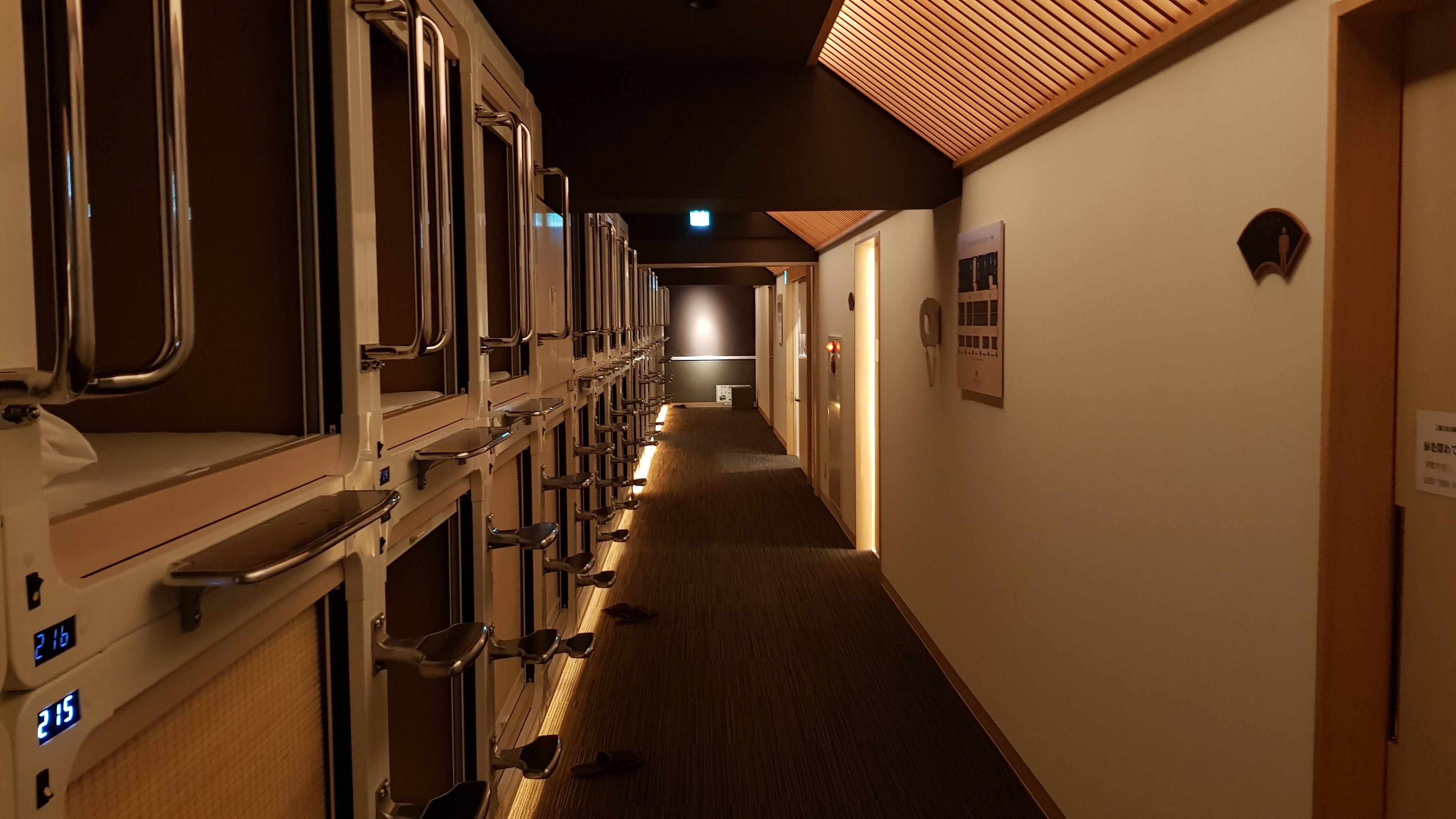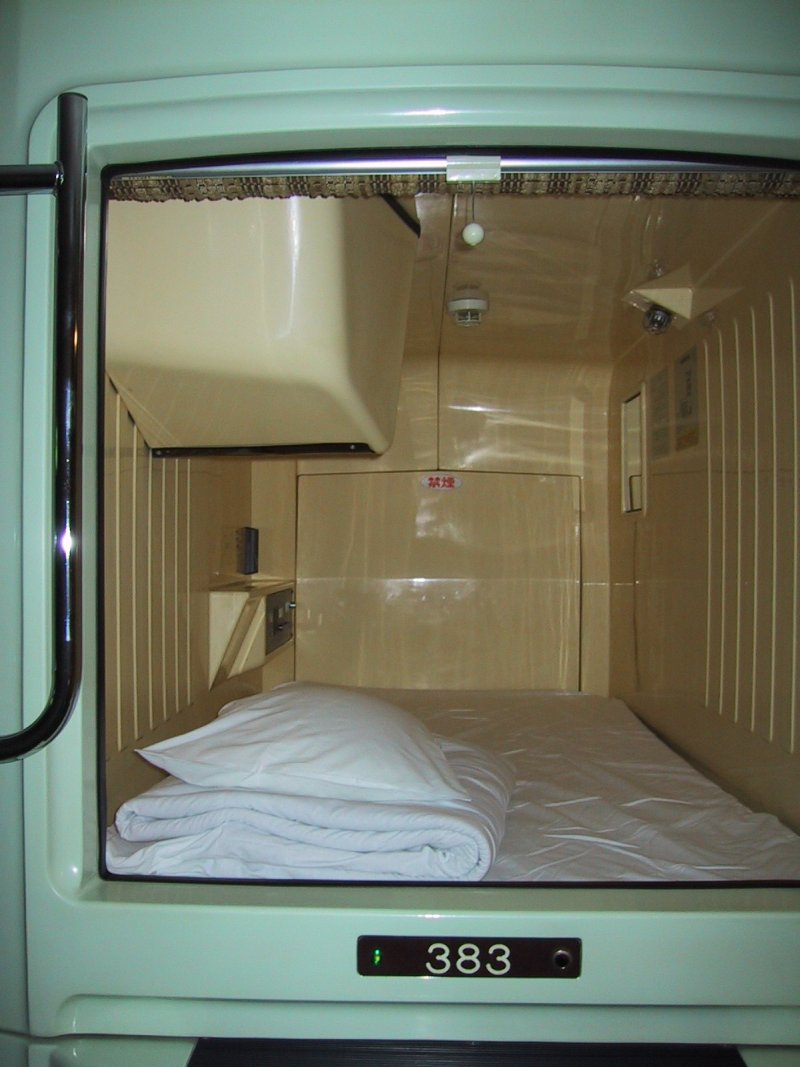Capsule hotel on:
[Wikipedia]
[Google]
[Amazon]

 Capsule hotel ( ja, カプセルホテル, kapuseru hoteru), also known in the
Capsule hotel ( ja, カプセルホテル, kapuseru hoteru), also known in the
 Like a
Like a
Japan's most stylish/strange hotels
/ref> In addition, because of the small interior space, ''Forbes'' advised that
A list of capsule hotels
{{DEFAULTSORT:Capsule Hotel Hotel types Hotels in Japan Homelessness Japanese inventions 1979 introductions 1979 establishments in Japan

 Capsule hotel ( ja, カプセルホテル, kapuseru hoteru), also known in the
Capsule hotel ( ja, カプセルホテル, kapuseru hoteru), also known in the Western world
The Western world, also known as the West, primarily refers to the various nations and states in the regions of Europe, North America, and Oceania.
as a pod hotel, is a type of hotel
A hotel is an establishment that provides paid lodging on a short-term basis. Facilities provided inside a hotel room may range from a modest-quality mattress in a small room to large suites with bigger, higher-quality beds, a dresser, a re ...
developed in Japan
Japan ( ja, 日本, or , and formally , ''Nihonkoku'') is an island country in East Asia. It is situated in the northwest Pacific Ocean, and is bordered on the west by the Sea of Japan, while extending from the Sea of Okhotsk in the n ...
that features many small bed-sized rooms known as capsules. Capsule hotels provide cheap, basic overnight accommodation for guests who do not require or who cannot afford larger, more expensive rooms offered by more conventional hotels.
The first capsule hotel in the world opened in 1979 and was the Capsule Inn Osaka, located in the Umeda
is a major commercial, business, shopping and entertainment district in Kita-ku, Osaka, Japan, and the city's main northern railway terminus (Ōsaka Station, Umeda Station). The district's name means "plum field".
History
Umeda was historical ...
district of Osaka
is a designated city in the Kansai region of Honshu in Japan. It is the capital of and most populous city in Osaka Prefecture, and the third most populous city in Japan, following Special wards of Tokyo and Yokohama. With a population of ...
, Japan and designed by Kisho Kurokawa. From there, it spread to other cities within Japan. Since then, the concept has further spread to various other territories, including Belgium, China, Hong Kong, Iceland, India, Indonesia, Israel, Poland and Canada.
Description
The guest room is a chamber roughly the length and width of a single bed, with sufficient height for a hotel guest to crawl in and sit up on the bed. The chamber walls may be made of wood, metal or any rigid material, but are often fibreglass or plastic. Amenities within the room generally include a small television, air conditioning, an electronic console, and power sockets. The capsules are stacked side-by-side, two units high, with steps or ladders providing access to the second level rooms, similar tobunk beds
A bunk bed is a type of bed in which one bed frame is stacked on top of another, allowing two or more beds to occupy the floor space usually required by just one. They are commonly seen on ships, in the military, and in hostels, dormitories, ...
. The open end of the capsule can be closed with a curtain or a solid door for privacy, but can be locked from the inside only.
 Like a
Like a hostel
A hostel is a form of low-cost, short-term shared sociable lodging where guests can rent a bed, usually a bunk bed in a dormitory, with shared use of a lounge and sometimes a kitchen. Rooms can be mixed or single-sex and have private or share ...
, many amenities are communally shared, including toilet
A toilet is a piece of sanitary hardware that collects human urine and feces, and sometimes toilet paper, usually for disposal. Flush toilets use water, while dry or non-flush toilets do not. They can be designed for a sitting position popu ...
s, shower
A shower is a place in which a person bathes under a spray of typically warm or hot water. Indoors, there is a drain in the floor. Most showers have temperature, spray pressure and adjustable showerhead nozzle. The simplest showers have a ...
s, wireless internet, and dining room
A dining room is a room for consuming food. In modern times it is usually adjacent to the kitchen for convenience in serving, although in medieval times it was often on an entirely different floor level. Historically the dining room is furnis ...
s. In Japan, a capsule hotel may have a communal bath and sauna. Some hotels also provide restaurants, snack bars or bars (or at least vending machine
A vending machine is an automated machine that provides items such as snacks, beverages, cigarettes, and lottery tickets to consumers after cash, a credit card, or other forms of payment are inserted into the machine or otherwise made. The fi ...
s), pools, and other entertainment facilities. There may be a lounge with upholstered chairs for relaxing, along with newspapers and reading material.
Capsule hotels vary in size, from 50 or so capsules to 700, and primarily cater to men. Some capsule hotels offer separate sections for male and female guests, or even separate floors and elevators. Clothes and shoes are exchanged for a ''yukata
A is an unlined cotton summer kimono, worn in casual settings such as summer festivals and to nearby bathhouses. Originally worn as bathrobes, their modern use is much broader, and are a common sight in Japan during summer. Though are traditi ...
'' and slippers on entry, and a towel and bathrobe
A bathrobe, also known as a housecoat or a dressing gown, is a loose-fitting outer garment (a robe) worn by people, often after washing the body or around a pool. A bathrobe is considered to be very informal clothing, and is not worn with every ...
may also be provided. Luggage and valuables are usually stored in lockers or—if available—in-room safe
A safe (also called a strongbox or coffer) is a secure lockable box used for securing valuable objects against theft or fire. A safe is usually a hollow cuboid or cylinder, with one face being removable or hinged to form a door. The body and ...
s. Guests are asked not to smoke or eat in the capsules.
Customer base
The benefit of these hotels are their convenience and low price, usually around ¥2000–4000 (USD –) a night. In Japan, capsule hotels have been stereotypically used by Japanese salarymen who may be too drunk to return home safely, have missed the last train of the day to make a return trip home due to working late hours, or are too embarrassed to face their spouses. During the Japanese Recession, some unemployed or underemployed workers who had become homeless during the crisis temporarily rented capsules by the month. As of 2010, these customers made up 30% of visitors at the Capsule Hotel Shinjuku 510 inTokyo
Tokyo (; ja, 東京, , ), officially the Tokyo Metropolis ( ja, 東京都, label=none, ), is the capital and largest city of Japan. Formerly known as Edo, its metropolitan area () is the most populous in the world, with an estimated 37.46 ...
.
Criticism and disadvantages
Due to the arrangement of capsules, ''Web Urbanist'' has compared the beds in capsule hotels to corpse drawers in a morgue./ref> In addition, because of the small interior space, ''Forbes'' advised that
claustrophobic
Claustrophobia is the fear of confined spaces. It can be triggered by many situations or stimuli, including elevators, especially when crowded to capacity, windowless rooms, and hotel rooms with closed doors and sealed windows. Even bedrooms with ...
guests should not use capsule hotels.
Some hotels may not provide air conditioning in the capsules, leading to poor air flow, especially with the privacy curtain or door shut; furthermore, due to the close proximity of guests, pods with thin plastic walls easily transmit sounds made by other guests bumping into the walls.
Because some capsule hotels are designed for single-night stays, guests intending to stay for more than one day must check out and back in again every day.
See also
* Sleepbox * Nap pod *Transit hotel
A transit hotel is a short-stay hotel that is situated in the transit zone of international airports, where passengers on extended waits between planes (typically a minimum of six hours) can stay while waiting for their next flight. The hotel is ...
* Bedspace apartment
A bedspace apartment (), also called cage home (), coffin cubicle, or coffin home, is a type of residence that is only large enough for one bunk bed surrounded by a metal cage. This type of residence originated in Hong Kong, and primarily exists ...
* Shipping container architecture
* Flophouse
References
External links
A list of capsule hotels
{{DEFAULTSORT:Capsule Hotel Hotel types Hotels in Japan Homelessness Japanese inventions 1979 introductions 1979 establishments in Japan